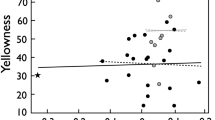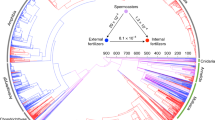Abstract
In postcopulatory sexual selection both sperm competition and cryptic female choice are considered to be important selective agents, but their relative importance for male fertilization success has received little attention. We tested whether sperm quality, male spawning coloration, male heterozygosity, and genetic overlap with the female explained a male’s fertilization success in controlled in vitro fertilization competition trials between equal numbers of sperm from pairs of male Arctic charr (Salvelinus alpinus), an external fertilizer. Offspring were genotyped to determine each males’ share of paternity. The velocity of a male’s sperm relative to the velocity of the competing male’s sperm was the best predictor of male fertilization success. Yet, sperm velocity was not related to spawning coloration or male heterozygosity. In fact, the most brightly colored male in a pair had the lowest fertilization probability. This could result from cryptic female choice for pale males, but might rather be a result of paler males producing more competitive sperm than more colored males. Furthermore, the more microsatellite alleles a male shared with the female relative to the competing male, the higher fertilization success he had. We argue that this latter may be an effect of assortative cryptic female choice, which might prevent hybridization with sympatric Arctic charr morphs or one form of kin selection.

Similar content being viewed by others
References
Ball MA, Parker GA (1996) Sperm competition games: external fertilization and “adaptive” infertility. J Theor Biol 180:141–150
Bierne N, David P, Boudry P, Bonhomme F (2002) Assortative fertilization and selection at larval stage in the mussels Mytilus edulis and M-galloprovincialis. Evolution 56:292–298
Billard R (1988) Artificial-insemination and gamete management in fish. Mar Behav Physiol 14:3–21
Birkhead TR, Fletcher F (1995) Male phenotype and ejaculate quality in the zebra finch Taeniopygia guttata. Proc R Soc Lond B Biol Sci 262:329–334
Birkhead TR, Møller AP (1998) Sperm competition and sexual selection. Academic, San Diego
Birkhead TR, Pizzari T (2002) Postcopulatory sexual selection. Nat Rev Genet 3:262–273
Birkhead TR, Moller AP, Sutherland WJ (1993) Why do females make it so difficult for males to fertilize their eggs. J Theor Biol 161:51–60
Birkhead TR, Buchanan KL, Devoogd TJ, Pellatt EJ, Szekely T, Catchpole CK (1997) Song, sperm quality and testes asymmetry in the sedge warbler. Anim Behav 53:965–971
Birkhead TR, Martinez JG, Burke T, Froman DP (1999) Sperm mobility determines the outcome of sperm competition in the domestic fowl. Proc R Soc Lond B Biol Sci 266:1759–1764
Blount JD, Moller AP, Houston DC (2001) Antioxidants, showy males and sperm quality. Ecol Lett 4:393–396
Cohen LB, Dearborn DC (2004) Great frigatebirds, Fregata minor, choose mates that are genetically similar. Anim Behav 68:1229–1236
Crawley MJ (2002) Statistical computing: an introduction to data analysis using S-Plus. Wiley, West Succex
Denk AG, Holzmann A, Peters A, Vermeirssen ELM, Kempenaers B (2005) Paternity in mallards: effects of sperm quality and female sperm selection for inbreeding avoidance. Behav Ecol 16:825–833
Eberhard WG (1996) Female control: sexual selection by cryptic female choice. Princeton University Press, New Jersey
Evans JP, Zane L, Francescato S, Pilastro A (2003) Directional postcopulatory sexual selection revealed by artificial insemination. Nature 421:360–363
Fabricius E (1953) Aquarium observations on the spawning behaviour of the char, Salmo alpinus. Rep Inst Freshw Res Drottningholm 34:14–48
Figenschou L, Folstad I, Liljedal S (2004) Lek fidelity of male Arctic charr. Can J Zool-Revue Canadienne De Zoologie 82:1278–1284
Foerster K, Delhey K, Johnsen A, Lifjeld JT, Kempenaers B (2003) Females increase offspring heterozygosity and fitness through extra-pair matings. Nature 425:714–717
Folstad I, Skarstein F (1997) Is male germ line control creating avenues for female choice? Behav Ecol 8:109–112
Froman DP, Feltmann AJ, Rhoads ML, Kirby JD (1999) Sperm mobility: a primary determinant of fertility in the domestic fowl (Gallus domesticus). Biol Reprod 61:400–405
Gage MJG, Macfarlane CP, Yeates S, Ward RG, Searle JB, Parker GA (2004) Spermatozoal traits and sperm competition in Atlantic salmon: relative sperm velocity is the primary determinant of fertilization success. Curr Biol 14:44–47
Geyer LB, Palumbi SR (2005) Conspecific sperm precedence in two species of tropical sea urchins. Evolution 59:97–105
Harper FM, Hart MW (2005) Gamete compatibility and sperm competition affect paternity and hybridization between sympatric Asterias sea stars. Biol Bull 209:113–126
Harvey PH, May RM (1989) Copulation dynamics—out for the sperm count. Nature 337:508–509
Hillgarth N, Ramenofsky M, Wingfield J (1997) Testosterone and sexual selection. Behav Ecol 8:108–109
Jonsson B, Jonsson N (2001) Polymorphism and speciation in Arctic charr. J Fish Biol 58:605–638
Kleven O, Jacobsen F, Robertson RJ, Lifield JT (2005) Extrapair mating between relatives in the barn swallow: a role for kin selection? Biol Lett 1:389–392
Knudsen R, Curtis MA, Kristoffersen R (2004) Aggregation of helminths: the role of feeding behavior of fish hosts. J Parasitol 90:1–7
Kortet R, Vainikka A, Rantala MJ, Taskinen J (2004) Sperm quality, secondary sexual characters and parasitism in roach (Rutilus rutilus L.). Biol J Linn Soc 81:111–117
Kupriyanova E, Havenhand JN (2002) Variation in sperm swimming behaviour and its effect on fertilization success in the serpulid polychaete Galeolaria caespitosa. Invertebr Reprod Dev 41:21–26
Lahnsteiner F, Berger B, Weismann T, Patzner RA (1998) Determination of semen quality of the rainbow trout, Oncorhynchus mykiss, by sperm motility, seminal plasma parameters, and spermatozoal metabolism. Aquaculture 163:163–181
Laird PW, Zijderveld A, Linders K, Rudnicki MA, Jaenisch R, Berns A (1991) Simplified mammalian DNA isolation procedure. Nucleic Acids Res 19:4293–4293
Lehmann L, Perrin N (2003) Inbreeding avoidance through kin recognition: choosy females boost male dispersal. Am Nat 162:638–652
Levitan DR (2000) Sperm velocity and longevity trade off each other and influence fertilization in the sea urchin Lytechinus variegatus. Proc R Soc Lond B Biol Sci 267:531–534
Liljedal S, Folstad I (2003) Milt quality, parasites, and immune function in dominant and subordinate Arctic charr. Can J Zool-Revue Canadienne De Zoologie 81:221–227
Liljedal S, Folstad I, Skarstein F (1999) Secondary sex traits, parasites, immunity and ejaculate quality in the Arctic charr. Proc R Soc Lond B Biol Sci 266:1893–1898
Locatello L, Rasotto MB, Evans JP, Pilastro A (2006) Colourful male guppies produce faster and more viable sperm. J Evol Biol 19:1595–1602
Masvaer M, Liljedal S, Folstad I (2004) Are secondary sex traits, parasites and immunity related to variation in primary sex traits in the Arctic charr? Proc R Soc Lond B Biol Sci 271:S40–S42
McCullagh P, Nelder JA (1989) General linear models. Chapman & Hall, London
Olsson M, Shine R, Madsen T, Gullberg A, Tegelstrom H (1996) Sperm selection by females. Nature 383:585–585
Palumbi SR (1999) All males are not created equal: Fertility differences depend on gamete recognition polymorphisms in sea urchins. Proc Natl Acad Sci USA 96:12632–12637
Parker GA (1970) Sperm competition and its evolutionary consequences in insects. Biol Rev Camb Philos Soc 45:525–567
Parker GA (1990a) Sperm competition games—raffles and roles. Proc R Soc Lond B Biol Sci 242:120–126
Parker GA (1990b)) Sperm competition games—sneaks and extra-pair copulations. Proc R Soc Lond B Biol Sci 242:127–133
Peters A, Denk AG, Delhey K, Kempenaers B (2004) Carotenoid-based bill colour as an indicator of immunocompetence and sperm performance in male mallards. J Evol Biol 17:1111–1120
Pilastro A, Simonato M, Bisazza A, Evans JP (2004) Cryptic female preference for colorful males in guppies. Evolution 58:665–669
Rakitin A, Ferguson MM, Trippel EA (1999) Spermatocrit and spermatozoa density in Atlantic cod (Gadus morhua): correlation and variation during the spawning season. Aquaculture 170:349–358
Ratti O, Hovi M, Lundberg A, Tegelstrom H, Alatalo RV (1995) Extra-pair paternity and male characteristics in the Pied Flycatcher. Behav Ecol Sociobiol 37:419–425
R Core Development team (2004) R: A language and environment for statistical computing. R Foundation for Statistical Computing. In. Vienna, Austria
Rexroad CE, Coleman RL, Martin AM, Hershberger WK, Killefer J (2001) Thirty-five polymorphic microsatellite markers for rainbow trout (Oncorhynchus mykiss). Anim Genet 32:317–319
Rudolfsen G, Figenschou L, Folstad I, Tveiten H, Figenschou M (2006) Rapid adjustments of sperm characteristics in relation to social status. Proc R Soc Lond B Biol Sci 273:325–332
Sheldon BC (1994) Male phenotype, fertility, and the pursuit of extra-pair copulations by female birds. Proc R Soc Lond B Biol Sci 257:25–30
Sherman CDH, Wapstra E, Uller T, Olsson M (2008) Males with high genetic similarity to the females sire more offspring in sperm competition in Peron’s tree frog Litoria peronii. Proc R Soc Lond B Biol Sci 275:971–978 DOI 10.1098/rspb.2007.1626
Sigurjonsdottir H, Gunnarsson K (1989) Alternative mating tactics of Arctic charr, Salvelinus Alpinus, in Thingvallavatn, Iceland. Environ Biol Fisches 26:159–176
Simmons LW (2001) Sperm competition and its evolutionary consequences in the insects. Princeton University Press, New Jersey, USA
Skarstein F, Folstad I (1996) Sexual dichromatism and the immunocompetence handicap: An observational approach using Arctic charr. Oikos 76:359–367
Skarstein F, Folstad I, Liljedal S (2001) Whether to reproduce or not: immune suppression and costs of parasites during reproduction in the Arctic charr. Can J Zool-Revue Canadienne De Zoologie 79:271–278
Skarstein F, Folstad I, Liljedal S, Grahn M (2005) MHC and fertilization success in the Arctic charr (Salvelinus alpinus). Behav Ecol Sociobiol 57:374–380
Snook RR (2005) Sperm in competition: not playing by the numbers. Trends Ecol Evol 20:46–53
Stoltz JA, Neff BD (2006) Sperm competition in a fish with external fertilization: the contribution of sperm number, speed and length. J Evol Biol 19:1873–1881 DOI 10.1111/j.1420-9101.2006.01165.x
Tarvin KA, Webster MS, Tuttle EM, Pruett-Jones S (2005) Genetic similarity of social mates predicts the level of extrapair paternity in splendid fairy-wrens. Anim Behav 70:945–955
Thornhill R (1983) Cryptic Female Choice and Its Implications in the Scorpionfly Harpobittacus-Nigriceps. Am Nat 122:765–788
Tregenza T, Wedell N (2000) Genetic compatibility, mate choice and patterns of parentage: invited review. Mol Ecol 9:1013–1027
Tregenza T, Wedell N (2002) Polyandrous females avoid costs of inbreeding. Nature 415:71–73
Turner E, Montgomerie R (2002) Ovarian fluid enhances sperm movement in Arctic charr. J Fish Biol 60:1570–1579
Urbach D, Folstad I, Rudolfsen G (2005) Effects of ovarian fluid on sperm velocity in Arctic charr (Salvelinus alpinus). Behav Ecol Sociobiol 57:438–444
Vaz Serrano J, Folstad I, Rudolfsen G, Figenschou L (2006) Do the fastest sperm within an ejaculate swim faster in subordinate than in dominant males of Arctic char? Can J Zool 84:1019–1024 DOI 10.1139/Z06-097
Westgaard JI, Klemetsen A, Knudsen R (2004) Genetic differences between two sympatric morphs of Arctic charr confirmed by microsatellite DNA. J Fish Biol 65:1185–1191
Yasui Y (1997) A “good-sperm” model can explain the evolution of costly multiple mating by females. Am Nat 149:573–584
Acknowledgements
Eirik Mack Eilertsen, Davnah Urbach, and Andreas Palmèn are acknowledged for enduring endless sessions of egg counting. E. M. Eilertsen is also the brain behind our ingenious, yet expensive, hatchery. Jon-Ivar Westgaard provided information about the microsatellite primers and PCR protocols. Jakob Lohm and Anne Grethe Hestnes never got tired of sharing their insights in various molecular biology techniques. Audun Stien introduced S. L. to quasibinomial tests and how to produce them, and additional plots, in the R software. Bård Jørgen Bårdsen was also very helpful teaching S. L. how to use R. Torkild Tveraa, Frode Skarstein, Jan T. Lifjeld and Anders P. Møller gave immensely improving comments to the manuscript.
Author information
Authors and Affiliations
Corresponding author
Additional information
Communicated by C. St. Mary
Rights and permissions
About this article
Cite this article
Liljedal, S., Rudolfsen, G. & Folstad, I. Factors predicting male fertilization success in an external fertilizer. Behav Ecol Sociobiol 62, 1805–1811 (2008). https://doi.org/10.1007/s00265-008-0609-1
Received:
Revised:
Accepted:
Published:
Issue Date:
DOI: https://doi.org/10.1007/s00265-008-0609-1




